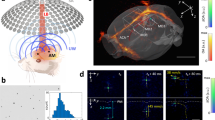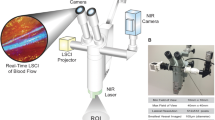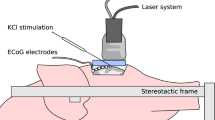Abstract
We present a method to produce vascular disruptions within rat brain parenchyma that targets single microvessels. We used two-photon microscopy to image vascular architecture, to select a vessel for injury and to measure blood-flow dynamics. We irradiated the vessel with high-fluence, ultrashort laser pulses and achieved three forms of vascular insult. (i) Vessel rupture was induced at the highest optical energies; this provides a model for hemorrhage. (ii) Extravasation of blood components was induced near the lowest energies and was accompanied by maintained flow in the target vessel. (iii) An intravascular clot evolved when an extravasated vessel was further irradiated. Such clots dramatically impaired blood flow in downstream vessels, in which speeds dropped to as low as ∼10% of baseline values. This demonstrates that a single blockage to a microvessel can lead to local cortical ischemia. Lastly, we show that hemodilution leads to a restoration of flow in secondary downstream vessels.
This is a preview of subscription content, access via your institution
Access options
Subscribe to this journal
Receive 12 print issues and online access
$259.00 per year
only $21.58 per issue
Buy this article
- Purchase on Springer Link
- Instant access to full article PDF
Prices may be subject to local taxes which are calculated during checkout







Similar content being viewed by others
References
Hudetz, A.G. Percolation phenomenon: The effect of capillary network rarefaction. Microvasc. Res. 45, 1–10 (1993).
Moody, D.M., Bell, M.A. & Challa, V.R. Features of the cerebral vascular pattern that predict vulnerability to perfusion or oxygenation deficiency: An anatomic study. AJNR Am. J. Neuroradiol. 11, 431–439 (1990).
Brozici, M., van der Zwain, A. & Hillen, B. Anatomy and functionality of leptomeningeal anastomoses: A review. Stroke 34, 2750–2762 (2003).
Cox, S.B., Woolsey, T.A. & Rovainen, C.M. Localized dynamic changes in cortical blood flow with whisker stimulation corresponds to matched vascular and neuronal architecture of rat barrels. J. Cereb. Blood Flow Metab. 13, 899–913 (1993).
Iadecola, C. Neurovascular regulation in the normal brain and in Alzheimer's disease. Nat. Rev. Neurosci. 5, 347–360 (2004).
Wardlaw, J.M., Sandercock, P.A., Dennis, M.S. & Starr, J. Is breakdown of the blood-brain barrier responsible for lacunar stroke, leukoaraiosis, and dementia? Stroke 34, 806–812 (2003).
Cullen, K.M., Zoltan, K. & Stone, J . Pericapillary haem-rich deposits: Evidence for microhaemorrhages in aging human cerebral cortex. J. Cereb. Blood Flow Metab. 25, 1656–1667 (2005).
del Zoppo, G.J. Microvascular changes during cerebral ischemia and reperfusion. Cardiovascular and Brain Metabolism Reviews 6, 47–96 (1994).
Farkas, E. & Luiten, P.G.M. Cerebral microvascular pathology in aging and Alzheimer's disease. Prog. Neurobiol. 64, 575–611 (2001).
Watson, B.D., Dietrich, W.D., Busto, R., Wachtel, M.S. & Ginsberg, M.D. Induction of reproducible brain infarction by photochemically initiated thrombosis. Ann. Neurol. 17, 497–504 (1985).
Haseldonckx, M., van Bedaf, D., van de Ven, M., van Reempts, J. & Borgers, M. Vasogenic oedema and brain infarction in an experimental penumbra model. Acta Neurochir. (Wien) 76 (Suppl.), 105–109 (2000).
Vogel, A. & Venugopalan, V. Mechanisms of pulsed laser ablation of biological tissues. Chem. Rev. 103, 577–644 (2003).
Svoboda, K., Denk, W., Kleinfeld, D. & Tank, D.W. In vivo dendritic calcium dynamics in neocortical pyramidal neurons. Nature 385, 161–165 (1997).
Kleinfeld, D., Mitra, P.P., Helmchen, F. & Denk, W. Fluctuations and stimulus-induced changes in blood flow observed in individual capillaries in layers 2 through 4 of rat neocortex. Proc. Natl. Acad. Sci. USA 95, 15741–15746 (1998).
Dawson, D.A. & Hallenbeck, J.M. Acute focal ischemia-induced alterations in MAP2 immunostaining: Description of temporal changes and utilization as a marker for volumetric assessment of acute brain injury. J. Cereb. Blood Flow Metab. 16, 170–174 (1996).
Latov, N. et al. Fibrillary astrocytes proliferate in response to brain injury. Dev. Biol. 72, 381–384 (1979).
Chapman, J.D., Franko, A.J. & Sharplin, J. A marker for hypoxic cells in tumours with potential clinical applicability. Br. J. Cancer 43, 546–550 (1981).
Asplund, K. Haemodilution for acute ischaemic stroke (a review). Cochrane Database Syst. Rev. 3, 1–41 (2005).
Sakharov, D.V., Barrett-Bergshoeff, M., Hekkenberg, R.T. & Rijken, D.C. Fibrin-specificity of a plasminogen activator affects the efficiency of fibrinolysis and responsiveness to ultrasound: Comparison of nine plasminogen activators in vitro. Thromb. Haemost. 81, 605–612 (1999).
The GUSTO Angiographic Investigators. The effects of tissue plasminogen activator, streptokinase, or both on coronary-artery patency, ventricular function, and survival after acute myocardial infarction. N. Engl. J. Med. 319, 1615–1622 (1993).
Lyden, P.D. Thrombolytic Stroke Therapy, 2nd Edition (Humana Press, New Jersey, 2004).
Skalak, R., Chen, P.H. & Chien, S. Effect of hematocrit and rouleaux on apparent viscosity in capillaries. Biorheology 9, 67–83 (1972).
Goldman, D. & Popel, A.S. A computational study of the effect of capillary network anastomoses and tortuosity on oxygen transport. J. Theor. Biol. 206, 181–194 (2000).
Schaffer, C.B. et al. Two-photon imaging of cortical surface microvessels reveals a robust redistribution in blood flow after vascular occlusion. Public Library of Science, Biology; in the press.
Baron, J.C. Perfusion thresholds in human cerebral ischemia: Historical perspective and therapeutic implications. Cerebrovasc. Dis. 11, 2–8 (2001).
Hossmann, K.A. Viability thresholds and the penumbra of focal ischemia. Ann. Neurol. 36, 557–565 (1994).
Zhao, W., Belayev, L. & Ginsberg, M.D. Transient middle cerebral artery occlusion by intraluminal suture II. Neurological deficits, and pixel-based correlation of histopathology with local blood flow and glucose utilization. J. Cereb. Blood Flow Metab. 17, 1281–1290 (1997).
O'Brien, J.T. et al. Vascular cognitive impairment. Lancet Neurol. 2, 89–98 (2003).
Dobrogowska, D.H., Lossinsky, A.S., Tarnawski, M. & Vorbrodt, A.W. Increased blood-brain barrier permeability and endothelial abnormalities induced by vascular endothelial growth factor. J. Neurocytol. 27, 163–173 (1998).
Rosenberg, G.A., Mun-Bryce, S., Wesley, M. & Kornfeld, M. Collagenase-induced intracerebral hemorrhage in rats. Stroke 21, 801–807 (1990).
Dijkhuizen, R.M., Asahi, M., Wu, O., Rosen, B.R. & Lo, E.H. Rapid breakdown of microvascular barriers and subsequent hemorrhagic transformation after delayed recombinant tissue plasminogen activator treatment in a rat embolic stroke model. Stroke 33, 2100–2104 (2002).
Kaufman, H.H. et al. A rabbit model of intracerebral hematoma. Acta Neuropathol. (Berl.) 65, 318–321 (1985).
Fazekas, F. et al. Histopathologic analysis of foci of signal loss on gradient-echo T2*-weighted MR images in patients with spontaneous intracerebral hemorrhage: Evidence of microangiopathy-related microbleeds. AJNR Am. J. Neuroradiol. 20, 637–642 (1999).
Lyden, P.D., Jackson-Friedman, C., Shin, C. & Hassid, S. Synergistic combinatorial stroke therapy: A quantal bioassay of a GABA agonist and a glutamate antagonist. Exp. Neurol. 163, 477–489 (2000).
Longa, E.Z., Weinstein, P.R., Carlson, S. & Cummins, R. Reversible middle cerebral artery occlusion without craniectomy in rats. Stroke 20, 84–91 (1989).
Wei, L., Rovainen, C.M. & Woolsey, T.A. Ministrokes in rat barrel cortex. Stroke 26, 1459–1462 (1995).
Yao, H. et al. Photothrombotic middle cerebral artery occlusion and reperfusion laser system in spontaneously hypertensive rats. Stroke 34, 2716–2721 (2003).
Nakase, H., Kakizaki, T., Miyamoto, K., Hiramatsu, K. & Sakaki, T. Use of local cerebral blood flow monitoring to predict brain damage after disturbance to the venous circulation: Cortical vein occlusion model by photochemical dye. Neurosurgery 37, 280–285 (1995).
Takeo, S., Miyake, K., Minematsu, R., Tanonaka, K. & Konishi, M. In vitro effect of naftidrofuryl oxalate on cerebral mitochondria impaired by microsphere-induced embolism in rats. J. Pharmacol. Exp. Ther. 248, 1207–1214 (1989).
Kudo, M., Aoyama, A., Ichimori, S. & Fukunaga, N. An animal model of cerebral infarction. Homologous blood clot emboli in rats. Stroke 13, 505–508 (1982).
Futrell, N. et al. A new model of embolic stroke produced by photochemical injury to the carotid artery in the rat. Ann. Neurol. 23, 251–257 (1988).
Lo, E.H., Dalkara, T. & Moskowitz, M.A. Mechanisms, challenges and opportunities in stroke. Nat. Rev. Neurosci. 4, 399–415 (2003).
Kleinfeld, D. & Delaney, K.R. Distributed representation of vibrissa movement in the upper layers of somatosensory cortex revealed with voltage sensitive dyes. J. Comp. Neurol. 375, 89–108 (1996).
Tsai, P.S. et al. Principles, design, and construction of a two photon laser scanning microscope for in vitro and in vivo brain imaging. In In Vivo Optical Imaging of Brain Function (ed. Frostig, R.D. ed.) 113–171 (CRC Press, Boca Raton, 2002).
Tsai, P.S. et al. All-optical histology using ultrashort laser pulses. Neuron 39, 27–41 (2003).
Backus, S. et al. High-efficiency, single-stage 7-kHz high-average-power ultrafast laser system. Opt. Lett. 26, 465–467 (2001).
Zhang, R.L., Zhang, Z.G. & Chopp, M. Increased therapeutic efficacy with rt-PA and anti-CD18 antibody treatment of stroke in the rat. Neurology 15, 273–279 (1999).
Korninger, C. & Collen, D. Studies on the specific fibrinolytic effect of human extrinsic (tissue-type) plasminogen activator in human blood and in various animal species in vitro. Thromb. Haemost. 46, 561–565 (1981).
Scremin, O.U. Cerebral vascular system. In The Rat Nervous System (Paxinos, G. ed.) 3–35 (Academic Press, Inc., San Diego, 1995).
Acknowledgements
We thank Q. Cheng for assistance with the plasminogen activator experiments, E. Dolnick for assistance with the electronics, D. Pizzo and L. Thal for use of their photomicroscope, L. Schroeder and S. Siegel for discussions, and Coherent, Inc. for the loan of equipment. This work was funded by the David and Lucille Packard Foundation, the National Science Foundation (DBI/0455027), the National Institutes of Health (NS/041096, NS/043300, EB/003832 and RR/021907), a La Jolla Interfaces in Science Postdoctoral Fellowship to C.B.S. and a National Science Foundation Graduate Fellowship to N.N.
Author information
Authors and Affiliations
Corresponding author
Ethics declarations
Competing interests
The authors declare no competing financial interests.
Supplementary information
Rights and permissions
About this article
Cite this article
Nishimura, N., Schaffer, C., Friedman, B. et al. Targeted insult to subsurface cortical blood vessels using ultrashort laser pulses: three models of stroke. Nat Methods 3, 99–108 (2006). https://doi.org/10.1038/nmeth844
Received:
Accepted:
Published:
Issue Date:
DOI: https://doi.org/10.1038/nmeth844
This article is cited by
-
Laser interstitial thermal therapy for deep-seated perivascular brain tumors is not associated with distal ischemia
Journal of Neuro-Oncology (2024)
-
Imaging the time course, morphology, neuronal tissue compression, and resolution of cerebral microhemorrhages in mice using intravital two-photon microscopy: insights into arteriolar, capillary, and venular origin
GeroScience (2023)
-
Three-dimensional microenvironment regulates gene expression, function, and tight junction dynamics of iPSC-derived blood–brain barrier microvessels
Fluids and Barriers of the CNS (2022)
-
Multimodal microwheel swarms for targeting in three-dimensional networks
Scientific Reports (2022)
-
Long-term in vivo imaging of mouse spinal cord through an optically cleared intervertebral window
Nature Communications (2022)



